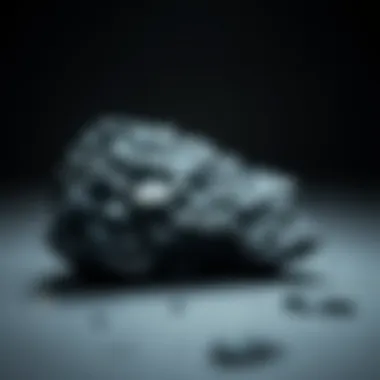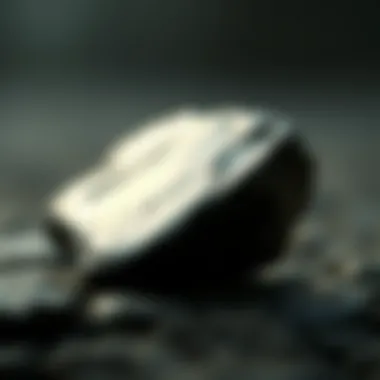Mastering the Art of Identifying Black Crystals


Intro
Black crystals have a certain allure that draws many to them, shrouded in mystery yet grounded in earthy origins. Their deep tones, robust energy, and striking appearances make them a favorite among rock and fossil collectors. While black may often represent the absence of light, these crystals can shed light into the realms of history, healing, and craftsmanship.
Understanding black crystals isn't just about aesthetics; it's about appreciating their unique properties and the stories behind them. Whether you’re a newcomer eager to dip your toes into the world of mineral collecting or a seasoned collector seeking to deepen your knowledge, this guide aims to serve as a compass, helping you navigate through the diverse landscape of black gemstones. Proper identification and comprehension of these gems can vastly enrich one’s collecting experience.
In this guide, we will explore various aspects of black crystals including:
- Their distinct characteristics and how to identify them.
- The historical significance they hold across different cultures.
- The classification and notable categories of black gemstones.
- Their uses in healing and crafts.
With clarity and engaging detail, this exploration promises to be comprehensively enlightening.
Foreword to Black Crystals
Black crystals hold a unique allure, captivating collectors and enthusiasts alike. These intriguing minerals, often enveloped in myths and legends, resonate with those drawn to their deep, mysterious hues. They are not just visually striking; black crystals also present a wealth of knowledge regarding their formation, properties, and potential applications. In a world where color often dominates aesthetics, the understated elegance of black gemstones offers a refreshing perspective. Collectors seeking to diversify their collections will find that these samples not only add depth but also have a rich narrative behind them.
Understanding Black Crystals
At the heart of the fascination with black crystals is a need to understand what defines them. Black-colored minerals can arise from various geological processes, influencing their properties and characteristics. For instance, black obsidian, a volcanic glass, is born from rapidly cooled lava, while black tourmaline, derived from a complex chemical process, showcases striking physical features. Understanding these processes deepens appreciation and knowledge about the natural world, aiding collectors in making informed decisions when sourcing or purchasing these stones.
The significance of color in crystals cannot be overstated. Black crystals symbolize protection and grounding. Many believe they can absorb negative energies and help maintain emotional balance. This metaphysical association adds another layer to their appeal, particularly for those who engage in practices such as crystal healing or meditation.
Significance in Collecting
The act of collecting black crystals goes beyond mere possession; it involves a connection with nature’s artistry and a commitment to understanding its wonders. Each unique piece tells a story, reflecting the Earth’s geological history, a narrative that piques the interest of even the most seasoned collectors. Moreover, many black crystals hold cultural significance, appearing in various spiritual beliefs and practices across different societies.
In collecting, it's vital to note the uniqueness of each specimen. Not all black crystals are created equal, and variations in hue, texture, and translucency can significantly affect value and appeal. Factors such as origin, size, and quality also play a crucial role when assessing potential purchases. Both novice and expert collectors are advised to stay informed and engaged within communities that focus on black crystals. Online forums, such as those found on Reddit or crystal-focused Facebook groups, serve as excellent resources for sharing insights and experiences.
Physical Properties of Black Crystals
Understanding the physical properties of black crystals is pivotal for collectors and enthusiasts alike, providing insights that aid in the identification and appreciation of these remarkable formations. Unlike your everyday rocks, black crystals boast unique characteristics that can tell a story about their origin and potential uses. Knowing what to look for can mean the difference between identifying a genuine gemstone or being swindled with a mere imitation.
Color Variations
At first glance, black crystals might seem homogenous, yet the shades can range significantly based on their mineral composition. Not all black is created equal; some stones appear as deep as the night sky, while others have subtle undertones of blue, green, or even brown.
Take obsidian, for example — it often glimmers with a dark sheen, yet depending on light refraction, you might catch glimpses of color swirling beneath the surface. In contrast, black tourmaline can showcase a slightly lighter shade with a robust texture that feels distinctly different than the smooth surface of obsidian. This means that, as a collector, one should not only look at the color but consider how it interacts with light and what additional hues may present themselves.
Transparency and Luster
The transparency of black crystals varies widely. Some, like jet, are opaque and absorb light, while others, such as black tourmaline, may display a somewhat translucent quality. This difference plays a significant role in their aesthetic appeal and utility in jewelry making or decorative crafts.
When assessing luster, the term refers to how a mineral reflects light. Black crystals may be categorized into different types of luster such as glossy, waxy, or even matte. Obsidian, well known for its glassy luster, often captivates collectors with its mirror-like finish. Conversely, the rough form of black onyx might show a satin luster, appealing to those who prefer a more understated elegance. Knowing how to appraise these qualities helps buyers select the type of crystal that aligns with their personal style and intended use.
Hardness and Durability
Hardness, measured by the Mohs scale, indicates how resistant a mineral is to scratching. This trait is instrumental not only for collectors but also for artisans. For example, black tourmaline ranks between 7 to 7.5 on the Mohs scale, making it quite resilient in jewelry settings. It can withstand daily wear and tear, which is a consideration for jewelers when crafting enduring pieces. In contrast, fragile minerals, like jet, which is much softer at around 2.5-4, require greater care and should be treated delicately to avoid damage.
Durability also encompasses how well a crystal can handle environmental factors such as heat, moisture, and chemicals. Certain black crystals, like black diamonds, have exceptional toughness, making them prized not only for their beauty but also for their strength and longevity. Understanding these properties ensures that collectors can protect their investments while also enjoying their beauty.
"A well-cared-for black crystal can last a lifetime and beyond, becoming a cherished heirloom that tells a story through generations."
Ultimately, the physical properties of black crystals are not merely academic; they are the backbone of successful collecting and utilization. Whether one is gazing at a finished piece or embarking on a search for raw specimens, these characteristics provide essential clues in navigating the diverse world of black gemstones.
Common Types of Black Crystals
When it comes to black crystals, there's a rich tapestry of options for collectors and enthusiasts. Each variety stands out not just for its physical charcters, but also for its place in history and culture. Understanding these types is crucial for anyone seeking to deepen their knowledge in this fascinating area of mineralogy.


Obsidian
Occurrence
Obsidian is a naturally occurring volcanic glass formed when lava cools rapidly. It can mostly be found in regions with a volcanic history, such as the U.S. Pacific Northwest, parts of Mexico, and certain areas of Iceland. What makes obsidian a popular choice among collectors is its smooth, reflective surface that can come in various colors, including pure black. This unique characteristic of occurrence contributes directly to the appeal of obsidian, as it reveals the geological processes underlying its formation. However, it can be brittle, which is a consideration for collectors when handling it.
Uses
The uses of obsidian go beyond mere aesthetics. Historically, it has been utilized in tools and weapons due to its sharp edges when fractured. In modern times, it finds applications in jewelry, art, and even surgical instruments. Its glossy appearance makes it a sought-after material for decorative purposes. These advantageous features highlight why obsidian maintains a strong presence in the market, making it beneficial for those looking to understand the versatility of black crystals.
Black Tourmaline
Energy Properties
Often touted for its supposed energy properties, black tourmaline is believed to provide protection against negative energies. This crystal is often associated with grounding and shielding, making it essential in the realms of spiritual healing. For many, its reputation as a spiritual safeguard enhances its desirability as a collector's item. Collectors can appreciate the significant demand that black tourmaline commands, serving individuals from various backgrounds, from spiritual practitioners to geology enthusiasts.
Applications
When it comes to practical applications, black tourmaline is more than a pretty face. It's employed in various industries, including electronics, where it's used for its piezoelectric properties. Many people also place black tourmaline in their homes for its alleged protective benefits, further solidifying its standing as both a sustainable material and a potential guardian. Its diverse range of uses makes it a point of interest for anyone looking to expand their understanding of valuable minerals.
Jet
Historical Significance
Jet is not your average black crystal. Formed from the compressed remains of decayed wood, this organic gemstone has been cherished since ancient times, often used in jewelry and mourning attire. Its historical importance particularly shines during the Victorian era, when it was favored for grief-related adornments. The storyline of jet—how it moves from wood to a prized gemstone—offers a compelling narrative for collectors who appreciate a good story behind their specimens.
How to Identify
Identifying jet might necessitate some close scrutiny. When warm, jet leaves a distinct smell, reminiscent of burning wood. Additionally, its lighter weight compared to similar-looking stones can be a telling factor in identification. Its unique formation and features provide great benefits for collectors striving for accuracy in their collections, making jet a noteworthy addition to any selection of black stones.
Black Onyx
Cultural Importance
Black onyx has been a part of various cultures for centuries, often infused with symbolic meanings. In different civilizations, it has represented strength, willpower, and protection against negative energy. Whether it's used in amulets or ornamental carvings, its cultural significance adds a layer of richness to the material. Collectors can appreciate how onyx not only varies in visual beauty but also represents a wide array of cultural histories.
Distinguishing Features
To the untrained eye, black onyx might easily be confused with other black stones, but certain distinguishing features set it apart. Its bands of color—sometimes seen in shades of white or gray—can be a key identifier along with its smooth texture. Knowing how to identify onyx is crucial for collectors who value authenticity, helping to navigate the often murky waters of the crystal market.
Identification Techniques for Black Crystals
Identifying black crystals can be a bit like finding a needle in a haystack. Yet, with the right techniques, enthusiasts can discern significant characteristics that set each stone apart. The importance of these identification methods lies not only in recognizing the crystals but also in understanding their unique properties, origin, and how to best utilize them in various applications. Techniques such as visual inspection, physical tests, and chemical evaluations equip collectors and practitioners with the necessary tools for effective identification, fostering a deeper connection with these remarkable minerals.
Visual Inspection
Surface Features
When it comes to the surface features of black crystals, one must delve into the rich tapestry of textural variations that different types possess. Observing the surface can often reveal whether a crystal is naturally formed or if it has undergone treatment. For instance, the subtle sheen on obsidian versus the matte finish of natural jet can be a telltale sign.
This approach is favored in this guide because it allows for immediate visualization, saving time before undertaking more complex tests. Each black crystal's surface can present unique marks, such as the striations found on black tourmaline, which can greatly enhance identification attempts. However, one should be careful; some surface features might be subject to wear over time, complicating further observations.
Clarity Assessment
Next up is the clarity assessment, a straightforward yet powerful tool in discerning the quality of black crystals. Clearer specimens, such as black onyx, tend to be more sought after, while inclusions can detract from a crystal’s desirability. This clarity check is critical when considering gemstones for collection or therapeutic uses.
Its strength lies in its simplicity; just a careful observation can yield valuable insights. Yet, clarity assessments can sometimes be misleading if the crystal is opaque, requiring a deeper dive into other identification methods to confirm suspicions.
Physical Tests


Scratch Test
The scratch test is a classic in mineral identification. This technique capitalizes on the relative hardness of different minerals, as indicated by the Mohs scale. For example, a black tourmaline is harder than obsidian, which means it won’t easily scratch the latter.
This test is especially practical for quick on-site identification. Because it can be done with simple tools, it’s cost-effective for novices and experts alike. But, this test may risk damaging finer specimens, so caution is warranted when applying force.
Weight Comparison
Another handy technique is weight comparison. Crystals like jet are lightweight compared to their denser counterparts, such as black tourmaline. Weighing a specimen can give clues about its authenticity and classification. This technique is beneficial for distinguishing between similar-looking stones when visual cues fail.
However, understanding the general weight range for each crystal type can take some time and research, which might dissuade those looking for quick answers.
Chemical Tests
Reactivity with Acid
Chemical tests, like assessing reactivity with acid, serve as powerful methods to distinguish black crystals. For instance, limestone reacts noticeably, while quartz remains unaffected. This characteristic is remarkably useful, especially when dealing with potential fakes or imitations.
This method is reliable and usually results in clear reactions, but it demands some caution and respect for safety protocols to avoid damage to both the specimen and the experimenter.
Magnetic Property Checks
Lastly, we have the magnetic property checks. Certain black crystals, such as magnetite, will respond to magnetic fields, while others will not. This distinctive feature can help narrow down possibilities, especially in contrast with popular imitations that lack such magnetic qualities.
While this examination delivers a straightforward answer, it can also leave room for doubt if the equipment is not calibrated correctly or if the crystal's properties are misrepresented among similar specimens.
Ultimately, combining these identification techniques can paint a fuller picture, providing collectors with the confidence they need when exploring the enchanting world of black crystals.
By mastering these methods, one can enhance clarity in distinguishing genuine stones, enriching the entire collection experience.
The Role of Black Crystals in Healing
Black crystals hold a unique place not just in the realm of collecting but also in the field of holistic healing. Known for their striking appearance and robust energy, these stones are often sought after for their purported benefits. The role of black crystals in healing is multi-faceted, intertwining physical, emotional, and spiritual aspects. For enthusiasts, understanding this role can enhance their experience, adding layers of meaning beyond mere aesthetic value.
Metaphysical Properties
Metaphysical properties of black crystals encompass a variety of benefits that many practitioners claim enhance mental and emotional wellness.
Energy Protection
One of the most lauded characteristics of black crystals is their ability to provide energy protection. In a world increasingly filled with distractions and negative energies, this feature resonates strongly. Black Tourmaline, for instance, is often utilized as a shield against electromagnetic frequencies from devices. This energy protection acts as a sort of barrier, absorbing negativity and allowing the bearer to experience a more grounded state of being.
The unique aspect of energy protection provided by black crystals is perhaps their capacity to create a conducive space for personal energy regulation. When used during meditation or grounding exercises, these stones help maintain emotional balance. However, it should be noted that while many report qualitative improvements, empirical scientific evidence regarding these claims remains limited, making personal experience crucial in evaluating their effectiveness.
Grounding Qualities
Grounding qualities found in black crystals are another of their impressive benefits. The capability of these stones to connect individuals to Earth’s energy makes them particularly appealing for those navigating turbulent emotional landscapes. For collectors and healers alike, black Obsidian often stands tall as a choice for fostering connection with the present moment and stabilizing erratic thoughts or anxiety.
The essence of grounding qualities is tied closely to the chakra system, particularly the root chakra. By activating this energy center, black crystals are thought to help individuals establish a firm foundation, enabling them to act with clarity. However, leveraging the grounding aspects convincingly requires sincerity and intention; merely possessing the stone typically does not suffice.
Application in Crystal Healing Practices
The practical application of black crystals in healing is as varied as the stones themselves. These crystals can be incorporated in numerous practices ranging from meditation to body layouts.
- Meditation: Holding black crystals during meditation aims to enhance focus and protect the user from external disturbances.
- Wearing: Some prefer to wear these stones as jewelry, keeping their protective energies close throughout the day.
- Environmental: Placing black crystals around living spaces serves to purify environments, reducing stress and fostering tranquility.
As the world embraces more holistic practices, integrating black crystals within these methods has become not just a trend but a valuable tradition for many healers and collectors alike. While results can vary between individuals, the collective experiences continue to enrich the narrative surrounding these remarkable stones.


For further exploration, resources such as Wikipedia and relevant forums like Reddit can offer a wealth of information on the various applications of black crystals in healing practices.
Collecting and Caring for Black Crystals
Collecting black crystals not only caters to the aesthetic sensibilities of enthusiasts but also serves as a deep dive into the geological history of our planet. For those who have an eye for detail, caring for these unique gemstones enhances their durability and allows them to retain their beauty for years. It’s essential for collectors to understand the best practices in both collecting and maintaining these crystals, ensuring they remain vibrant and valuable in their collection.
Best Practices for Collectors
Display Techniques
Displaying black crystals is all about showcasing their unique features, color interplays, and forms. A well-thought-out display can be as fundamental as showing off their natural beauty or as intricate as telling a story through arrangement.
One popular choice among collectors is the use of crystal display cases. These cases not only protect the crystals from dust and accidental damage, but they also allow for a full view of their striking appearance. Furthermore, using adjustable lighting can highlight the luster and depth of color, bringing out the details that might otherwise go unnoticed.
However, improper lighting can also be detrimental. Direct sunlight can fade colors over time, especially in lighter-colored minerals. Thus, display techniques should balance visibility with protection. Another thing to note: glass shelves or cases might scratch softer crystals if not carefully chosen.
Storage Considerations
Proper storage is vital in maintaining the integrity of black crystals. This involves not just storing them but doing it thoughtfully. An often-advocated method is to keep each crystal in its own soft pouch or box to prevent scratches from occurrences during transportation or while simply gathering dust.
Temperature and humidity also play a significant role in crystal care. A stable environment, away from heat sources and extreme moisture, is crucial. For example, obsidian, famous for its smooth finish and sharp edges, can chip if not stored properly.
When it comes to storage options, a drawer or cabinet with a soft lining can work wonders. However, avoid overcrowding, as this can lead to unintentional stress and damage. Well-organized storage reinforces the idea that each piece has its own character and importance within the collection.
Cleaning and Maintenance
Safe Cleaning Methods
Keeping black crystals clean is essential for ensuring they maintain their visual appeal. While some might feel tempted to use any chemical cleaner, it's crucial to understand the mineral composition of each crystal before diving in. Mild soap and warm water is often the safest route for cleaning most black crystals. Using a soft brush can help dislodge any dirt without scratching the surface.
It’s also essential to rinse thoroughly and dry each piece completely after cleaning. This method isn’t just popular due to its effectiveness; it helps ensure that no residual soap or moisture is left to tarnish the crystal.
Preventing Damage
Preventing damage to black crystals goes beyond careful handling—it's about creating an environment that safeguards them. One effective approach is to routinely check for any signs of wear and tear, like chips or cracks, which can occur without apparent cause. Additionally, being aware of how crystals interact with one another is vital. Some minerals can subtly damage others if placed too close together.
A special mention for high-vibration crystals such as black tourmaline; they should ideally be stored separately to avoid any unwanted energetic interactions. For collectors, acknowledging and understanding these relationships can greatly extend the life and beauty of their crystal collections.
"Taking care of your crystals isn't just about their physical appearance; it's a respect for their energetic presence."
In summary, collecting and caring for black crystals involves an understanding that goes beyond mere acquisition. Display techniques, storage practices, cleaning methods, and preventive measures all contribute to a more enriching and long-lasting collection. By nurturing these unique minerals, collectors can ensure that their treasures not only endure but also continue to evolve in their beauty and significance.
Ending and Resources
In closing, the exploration of black crystals holds a particular significance for both collectors and enthusiasts alike. The unique attributes that define these crystals provide not just aesthetic allure but also practical applications in various fields like healing and geology. Summarizing the key identifiers shared within this guide allows readers to harness their knowledge effectively. Recognizing distinct mineral characteristics is crucial, as it empowers individuals to make informed decisions about purchases, displays, and even personal well-being practices utilizing crystals.
The resources provided are a gateway to deepen understanding and foster community engagement. By connecting with literature and like-minded individuals, collectors can enrich their practices extensively. The importance of ongoing learning cannot be overstated, as the realm of black crystals is expansive and continuously evolving. Not only does this empower collectors, but it also enhances the overall appreciation for these remarkable treasures of nature.
Summarizing Key Identifiers
When identifying black crystals, there are several key identifiers that can help discern one type from another:
- Color and Transparency: While several black crystals might appear similar at first glance, variations like transparency vary significantly. Some have a glassy appearance while others might be opaque.
- Luster and Surface Features: This can include everything from the smoothness of the surface to the presence of striations or natural imperfections.
- Unique Characteristics: Elements like streak color, specific gravity, or even magnetic properties can be telling. For example, black tourmaline often shows a distinct hardness and can be slightly magnetic.
Keeping these identifiers at the forefront can greatly ease the identification process.
Further Reading and Resources
Recommended Books
Exploring literature on black crystals provides immense value. A book like "The Crystal Bible" by Judy Hall serves as a classic reference, delving into various types and their meanings, helping in identification. The key characteristic of this book is its comprehensive nature; it is beneficial for both beginners and seasoned collectors. Its accessibility and readability make it a popular choice among enthusiasts. The unique feature lies in its vivid color photographs that help in visual identification, although some may find it lacking in deeper scientific dialogue if they seek exhaustive detail.
Online Communities
Participating in online communities such as forums on Reddit or groups on Facebook can greatly enhance one’s knowledge and experience. The central aspect of these online platforms is the opportunity for discussion and sharing firsthand experiences. Members typically benefit from a diverse range of perspectives, which can illuminate alternative approaches to collection, care, and identification. One standout feature of these communities is the real-time feedback members can provide, although the challenge lies in discerning reliable advice amid the vast sea of opinions.















